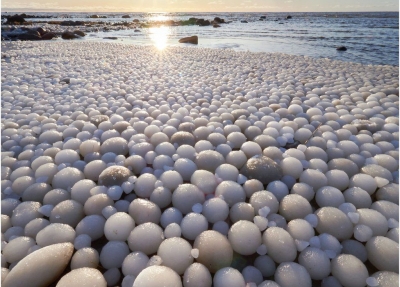
Ice eggs are a rare phenomenon in which small pieces of ice are rolled over by wind and water. Chunks of ice break off from larger ice sheets in the sea and wash up on shore on the incoming tide or are pushed in by gusts of wind at the water’s surface. Waves strike the ice chunks as they travel, slowly eroding their jagged edges into smooth curves. Seawater sticks and freezes to the forming eggs, causing them to grow. Once the ice chunks reach the shore, the pounding waves smooth out any lingering sharp edges on their surfaces, leaving behind shiny “eggs”.
Given enough time, the frozen balls can grow to become boulder size. In 2016, giant snowballs washed up on a beach in Siberia, some measuring a metre (about 3 feet) across. An ice specialist from the Finnish Meteorological Institute has been quoted as saying ice balls are rare but not unprecedented, and occur about once a year on the Finnish coastline as conditions allow. They also appear on the American Great Lakes where they are called Ice balls.
Credit : Wikipedia
Picture Credit : Google




